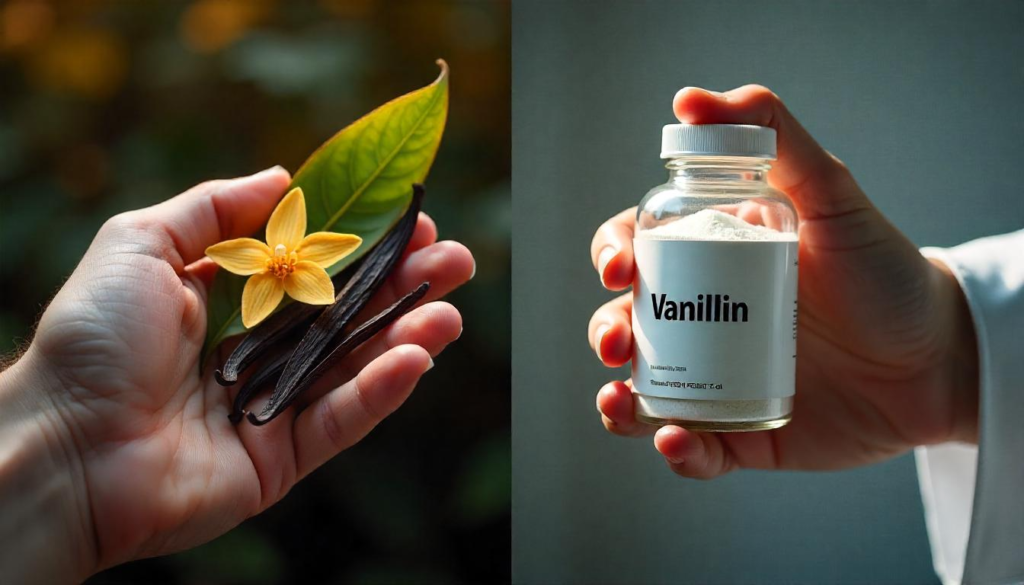When it comes to flavoring our favorite desserts, baked goods, and even savory dishes, vanilla is a beloved staple. But have you ever wondered about the difference between vanillin and vanilla? These two terms are often used interchangeably, yet they represent distinct entities with unique properties, uses, and costs. In this blog, we’ll explore vanillin vs vanilla, breaking down their sources, compositions, flavor profiles, and best applications. Whether you’re a home cook, a professional chef, or simply curious about food science, this guide will help you make informed choices in the kitchen.
Key Differences Between Vanillin and Vanilla
To make it easy to understand, here’s a quick comparison of vanillin vs vanilla:

| Aspect | Vanilla | Vanillin |
|---|---|---|
| Source | Natural extract from vanilla orchid pods | Can be natural (from beans) or synthetic (lab-made) |
| Composition | Over 200 compounds, including vanillin | Single compound (C₈H₈O₃) |
| Flavor Profile | Rich, complex, slightly floral | Simpler, more direct vanilla flavor |
| Cost | Expensive due to labor-intensive production | Cheaper, especially when synthetic |
| Uses | Artisanal baking, premium desserts | Mass-produced foods, cost-effective options |
Vanilla is prized for its depth and complexity, making it ideal for high-end, small-batch recipes like artisanal ice creams or gourmet pastries. Vanillin, especially the synthetic version, is a go-to for large-scale food production where cost and consistency are key, such as in commercial baked goods or beverages.
What is Vanillin?
Vanillin is the primary flavor compound responsible for the characteristic sweet, creamy taste of vanilla. Chemically known as C₈H₈O₃, vanillin can be extracted naturally from vanilla beans or produced synthetically in a lab. In fact, about 85% of commercial vanillin is synthetic, often derived from petrochemicals, making it a cost-effective option for mass-produced foods like ice cream, sodas, and cookies. Its flavor is straightforward and recognizable, though it lacks the depth of natural vanilla.
What is Vanilla?
Vanilla, on the other hand, is a natural flavor derived from the pods of the vanilla orchid (Vanilla planifolia). Grown in tropical regions like Madagascar and Indonesia, vanilla pods are harvested, cured, and extracted to produce vanilla extract—a complex mixture of over 200 compounds, with vanillin being the most prominent. This complexity gives vanilla its rich, nuanced flavor, often described as slightly floral and deeply aromatic. Due to the labor-intensive process of growing and curing vanilla pods, it’s one of the most expensive spices in the world, second only to saffron.
When to Use Vanillin vs Vanilla
Choosing between vanillin vs vanilla depends on your needs:
- Use Vanilla When:
- You want a rich, complex flavor that elevates premium desserts.
- You’re baking small batches where quality outweighs cost.
- You prefer natural ingredients without synthetic additives.
- Use Vanillin When:
- You’re cooking or baking on a budget.
- You need a consistent, straightforward vanilla flavor for mass-produced items.
- You’re making large quantities where cost efficiency is crucial.
For example, a homemade vanilla bean ice cream might call for pure vanilla extract to enhance its flavor, while a commercial cookie manufacturer might opt for synthetic vanillin to keep production costs low.
Cost Considerations
The price difference between vanillin and vanilla is stark. Vanilla’s high cost is due to its labor-intensive cultivation—each orchid must be hand-pollinated, and the pods take months to mature and cure. This makes vanilla extract a luxury ingredient, often reserved for special recipes. Vanillin, especially when synthetically produced, is significantly cheaper and more accessible, making it the default choice for many food manufacturers.
Interestingly, there’s also “natural vanillin,” produced through fermentation of rice or sugar. While it’s labeled as natural, it’s still just vanillin (not the full vanilla extract) and can cost hundreds of dollars per kilogram—far more than synthetic vanillin but without the complexity of true vanilla.
Are Vanillin and Vanilla Safe?
Both vanillin and vanilla are safe for consumption, as confirmed by food safety authorities like the FDA. Vanilla extract may offer additional compounds with potential health benefits, such as mood-boosting properties, though more research is needed. Some consumers prefer vanilla for its natural origins, avoiding synthetic additives. However, synthetic vanillin is widely used and considered safe, making it a practical choice for many.
Conclusion: Making the Right Choice for Your Needs
In the debate of vanillin vs vanilla, neither is inherently better—it depends on your priorities. If you’re after a rich, complex flavor and don’t mind the cost, vanilla is the way to go. For budget-friendly, consistent results in large-scale cooking, vanillin is a reliable option. At Avid Organics, we’re passionate about natural, sustainable ingredients, and while both have their place, we love the depth that pure vanilla brings to our creations. Next time you’re in the kitchen, consider what matters most—flavor, cost, or convenience—and choose accordingly. Have thoughts on vanillin vs vanilla? Share them in the comments below or explore more culinary tips on our site!
For more updates on our latest innovations, sustainability initiatives, and upcoming events, follow us on LinkedIn and stay connected through our official website. Stay tuned for exciting developments as we continue to push the boundaries of nutraceutical excellence!





